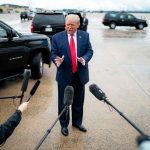Donald Trump is back in the White House transition game, and this time he seems determined not to trip over his own shoelaces—unlike last time, when he practically ran a marathon over the potholes of the “deep state.” The President-elect’s recent meetings, including a friendly gathering with President Joe Biden, reveal a calm demeanor that wasn’t present during the chaos of 2016. This go-around, Trump has thrown down the gauntlet against the bureaucratic deep state, signaling he’s ready to clean house.
So far, the signs of change are loud and clear. The Trump team appears far more organized than before, with a rapid-fire unveiling of cabinet picks that makes it look like a sports draft rather than a political transition. The selections are raising eyebrows not because they signal a return to the status quo, but rather because they demonstrate Trump’s refusal to play nice with establishment favorites. Whether it’s bypassing notable GOP figures like Nikki Haley and Mike Pompeo or opting for dedicated loyalists such as campaign head Susie Wiles as chief of staff, Trump is steering this ship in a new direction.
Trump won’t get fooled again: Transition team makes stark contrast with 2016 https://t.co/XLqQqXGF7A
— John Solomon (@jsolomonReports) November 14, 2024
It’s worth noting that Trump’s previous cabinet was a revolving door of chaos, largely due to his reliance on Washington insiders who often wound up on the wrong side of his policies. With his fresh hires, the former president seems committed to keeping a tighter ship. His selection of Pete Hegseth for Secretary of Defense is a clear indication that Trump is leaning toward those who understand both the battlefield and the constraints of federal bureaucracy. The drama of previous clashes with military advisors appears to be a thing of the past as Trump charts a course for a leaner, meaner administration.
Then there’s the matter of Senate dynamics. During his first term, Trump found himself dodging political landmines left and right, particularly with figures like Mitch McConnell and the late John McCain, who often knee-capped his initiatives. This time around, a new leader, Senator John Thune, has taken the helm of the Senate Republicans, and it seems Trump is taking a diplomatic approach instead of a boxing match. By sitting out the leadership race and letting Thune take the lead, Trump may be signaling a willingness to foster cooperation rather than conflict.
In his new regime, Trump is not just limiting his picks to familiar faces from the establishment but is also minimizing the risk of leaks and bureaucratic sabotage. His strategy includes a commitment to cracking down on leakers within government, taking a page from the previous playbook where unwanted stories seemed to sprout like weeds in the garden of his presidency. Appointing trusted allies like Tom Homan and Stephen Miller for key positions offers a double assurance: a commitment to promoting the Trump agenda while simultaneously shutting down the backchannels that led to so many headaches the first time around.
All of these moves signal that Trump is ready not just to reclaim the Oval Office, but to fundamentally reshape it into something more aligned with his vision of governance. The freshly-minted Department of Government Efficiency aims to streamline operations, reduce red tape, and snuff out unnecessary spending with the fiery enthusiasm of X platform’s Elon Musk and the innovative spirit of Vivek Ramaswamy. In this new administration, the motto seems to be: “Don’t just win; clean house.” For those who have had their fill of Washington swamp monsters, this transition marks a promising new chapter.




